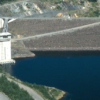Overview
Cobble Mountain Dam in Western Massachusetts is managed by the Springfield Water and Sewer Commission which provides water and sewer services to over 250,000 customers. The reservoir impounded by Cobble Mountain Dam provides one of the primary sources of drinking water for its customers, it is gravity fed to its West Parish Filtration Plant in Westfield, Massachusetts then is distributed by gravity feed and pumping through more than 617 miles (987 km) of transmission mains of varying sizes to the Commissions customers in Springfield and Ludlow, Massachusetts. The reservoir supplies up to 37.2 million gallons (141 million liters) of water per day to its customers. The dam, completed in 1931, consists of an earth and rock-fill structure with a crest length of 730 ft. (223 m) and a height of 263 ft. (80 m).
The dam impounds the Little River with a reservoir approximately 5 mi. (8 km) long, a capacity of approximately 25 billion gallons (97 billion liters) and an area of approximately 1034 acres. Picture of the reservoir is shown below. (Photo Courtesy Springfield Water and Sewer Commission)
Data Analysis
In addition to its importance as the second largest water reservoir in Massachusetts, Cobble Mountain Reservoir also provides hydropower for Cobble Mountain Station, a hydroelectric generating station built in 1930 by the City of Springfield, located about 2 mi. (3.2 km) downstream from Cobble Mountain Reservoir and just upstream from The Gorge on the Little River in Granville. The Station is owned by the Springfield Water and Sewer Commission and operated by Northeast Generation Services Company (NGS), a subsidiary of Northeast Utilities System (NUS). The Station contains three water wheel generators with a total rating of 30.6 megawatts. The Station’s purpose is to generate electricity while meeting the city’s demand for water from the water treatment plant. The output of the hydro-generators supplies the city’s feed water to the Springfield West Parish Filter water treatment system.
What We Did
Due to its height, age and importance to the water supply for Western Massachusetts, Cobble Mountain Dam has been designated a High Hazard Dam. This has provided for funding of various monitoring projects and other infrastructure improvements, particularly in light of the increased security concerns since 9/11. Geokon Vibrating Wire Piezometers were installed in 2000 to monitor pore pressures and water levels in and around the Dam, in addition to weir gages and seismic monitoring using a Kinemetrics Altus digital recorder with base station tri-axial accelerometer and 1 remote tri-axial accelerometer installed near the top of the dam.
System Design & Programming
Our services and products have been utilized as follows:
- Supply of MultiLogger software to provide the Springfield Water and Sewer Commission the ability to configure, monitor and collect data from the Campbell Scientific based Automated Data Acquisition System (ADAS).
- Investigation into the measurement difficulties experienced with the original system configuration and the vibrating wire measurements. These measurement difficulties were severe, resulting in less than 40% of measurements being usable. Investigation revealed the presence of DC potentials, installation of our VWDSP provided dramatic improvement in measurement quality with 99.9% measurement reliability. The chart at right shows pre-VWDSP and post-VWDSP measurements.
- Design of custom programming and electronics to support the communications and signaling required at the project. The following functions were implemented by us at the project site:
-
- Initiation of ADAS measurements due to seismic event, signaled by the on-site Kinemetrics Altus recorder.
- Alarms based on rate of change with multiple readings to verify alarm.
- Activation of a voice dialer and wireless CB in the event of an alarm, to alert key personnel to the alarm condition.
- Support for communication with the ADAS, for monitoring and data collection, using POTS (Plain Old Telephone Service) and the Springfield Water and Sewer Commissions high-speed WAN which extends to the Dam. Communication may be established using either method without modifying the system, primary communication is through the WAN, with POTS as backup.


